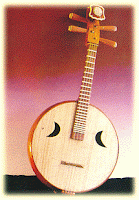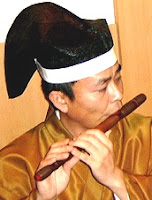| Name | Image | Tradition | Description |
|---|---|---|---|
| Rhodes Piano |  | United States | A Rhodes piano is an electromechanical musical instrument, a brand of electric piano. Its distinctive sound has appeared and still does in thousands of songs of all musical styles since it was first introduced in 1965. |
| Rhythmicon | United States | The Rhythmicon, also known as the Polyrhythmophone, was the world's first electronic drum machine (or rhythm machine). In 1930, the avant-garde American composer and musical theorist Henry Cowell commissioned Russian inventor Léon Theremin to create the remarkably innovative Rhythmicon. Cowell wanted an instrument with which to play compositions involving multiple rhythmic patterns impossible for one person to perform simultaneously on acoustic keyboard or percussion instruments. The invention, completed by Theremin in 1931, can produce up to sixteen different rhythms. The image shows Joseph Schillinger and the Rhythmicon (1932). | |
| Rih |  | Ukraine | The rih (Ukrainian: Ріг) (Rizhok, Lihava, Cossack Horn, Hornpipe) was a popular instrument in Eastern Ukraine, with between three and six fingerholes, or sometimes none. Usually they were made from a cylindrical reed with a cow's horn to form the bell. The mouthpiece usually has a single reed although occasionally double reed instruments can be found. |
| Ring of Bells |  | England | A "ring of bells" is a set of 3 to sixteen bells hung in a circle for change ringing, a particular method of ringing bells in patterns. Often hung in a church tower, such a set is usually tuned to the notes of a diatonic scale (without intervening chromatic notes). A peal in changing ringing may have bells playing for several hours, playing 5,000 or more patterns without a break or repetition. The distinctive feature of these English-style rings is that they are hung for full-circle ringing: each bell is suspended from a (usually wooden) headstock, which in turn is connected to the bellframe by bearings, allowing the bell to swing freely through just over 360 degrees; the headstock is fitted with a wooden wheel around which a rope is wrapped. The image shows the bell ringing in Stoke Gabriel parish church, south Devon, England. |
| Riqq |  | Egypt | The riqq (also known as riq or rik) is a type of tambourine used as a traditional instrument in Arabic music. It is an important instrument in both folk and classical music throughout the Arabic-speaking world. It traditionally has a wooden frame (although in the modern era it may also be made of metal), jingles, and a thin, translucent head made of fish skin (or, more recently, a synthetic material). Although in the West the tambourine is generally considered to be a simple rhythm instrument suited for unskilled performers, riq players are capable of great subtlety and virtuosity. The riq is used in Egypt, Iraq, Lebanon, Palestine, Sudan, and Syria; in Libya, where it is rare, it is called mriq. It is between 20 and 25 cm in diameter and is now effectively a man's instrument. |
| Rolmo |  | Tibet | Rolmo, a pair of cymbal with broad central bosses, are used in Tibetan Buddhist ceremonies. They are held one above the other and struck by vertical movement. |
| Roman Tuba | Italy | The Roman tuba is an ancient musical instrument, different from the modern tuba. Tuba (from tubus, Latin for tube) was produced around 500 BC, and like the Cornu (a similar instrument), was used as a military signal trumpet. The origin is Etruscan and has many similarities with the Greek Salpinx. It was a straight instrument, usually of bronze, about four feet long, and played with a detachable bone mouthpiece. This instrument, although disputed, could be the ancestor and the source of the name for the modern tuba. | |
| Rommelpot |  | Netherlands | Rommelpot is a friction drum from Netherlands. It is a percussion instrument consisting of a single membrane stretched over a sound box, whose sound is produced by the player causing the membrane to vibrate by friction. Rommelpot is rubbed with a rosined stick. In some parts of the Netherlands, e.g. on the island IJsselmonde, it was tradition, until the 1950s, to go from house to house on New Year's Eve singing songs to the rhythmic accompaniment of the rommelpot. This tradition is still maintained in North Holland on the feast of St. Martin. In Brabant rommelpot can also refer to the dance which is accompanied by the instrument. |
| Rondador |  | Ecuador | The rondador is a set of chorded bamboo panpipes that produces two tones simultaneously by blowing air across the top of two adjacent pipes simultaneously. It consists of pieces of cane, placed side by side in order by size and closed at one end. The rondador is considered the national instrument of Ecuador. Ecuadorian San Juanito is the most well known rhythm associated with this instrument. |
| Roneat |  | Cambodia | The roneat is a musical instrument used in the traditional and classical musics of Cambodia. It is used by both the Khmer majority as well as the nation's ethnic minorities. The roneat is a trough-resonated keyboard percussion instrument; generally played with two mallets. Roneat ek is a smaller xylophone. Roneat thung is a larger xylophone (see image). Roneat dek is a smaller metallophone. Roneat thong is a larger metallophone. It is no longer used. |
| Ruan |  | China | The ruan (阮) is a Chinese plucked string instrument. It is a lute with a fretted neck, a circular body, and four strings. Its strings were formerly made of silk but since the 20th century they have been made of steel (flatwound for the lower strings). The modern ruan has 24 frets with 12 semitones on each string, which has greatly expanded its range from a previous 13 frets. |
| Rubab |  | Afghanistan | Rubab or Robab is a lute-like musical instrument from Afghanistan. The rubab is mainly used in the classical music of Afghanistan. A short-necked lute made of wood, with goatskin covering the body, the rubab has three melody strings, three drone strings, and 11 or 12 sympathetic strings. The rubab is a fretted instrument with no bow. It is one of the two National Instruments of Afghanistan (together with the Zerbaghali). |
| Rudra Vina |  | India | The Rudra Veena (also spelled rudra vina, and also called been or bin) is a large plucked string instrument used in Hindustani music. It is an ancient instrument, and is rarely played in the present day. The rudra veena declined in popularity partly due to the decline of Dhrupad and the emergence of fast paced Khayal in the Indian Durbars. Rudra Veena has a long tubular body with length ranging between 54 to 62 inches made of wood or bamboo. Two large-sized, round resonators, made of dried and hollowed gourds, are attached under the tube. |
| Russian Guitar |  | Russia | The Russian guitar, a seven-string acoustic guitar tuned to the Open G tuning, arrived in the end of the 18th century-beginning of the 19th century in Russia, most probably as a development of the cittern, kobza and torban. It is known in Russia as the semistrunnaya gitara (семиструнная гитара), which translates to seven string guitar or affectionately as the semistrunka (семиструнка). Its invention is attributed to Andrei Sychra, who also wrote a method for the guitar, as well as over one thousand compositions. The Russian guitar is traditionally played without a pick, using fingers for either strumming or picking. |
| Ryuteki |  | Japan | The ryūteki (龍笛; literally "dragon flute") is a Japanese transverse flute made of bamboo. It is used in gagaku, the Shinto classical music associated with Japan's imperial court. The sound of the ryūteki is said to represent the dragons which ascend the skies between the heavenly lights (represented by the shō) and the people of the earth (represented by the hichiriki). The ryūteki is held horizontally, has seven holes, and has a length of 40 centimeters and an inner diameter of 1.3 centimeters. Unlike the western flute, the holes are not covered by the finger tips, rather, the fleshy part of the finger is used. This allows for better control of "half-holing" techniques and chromatic notes, by simply raising the finger slightly above the holes. |
Prev Top Next |